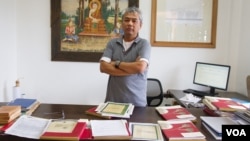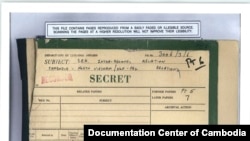Chhang Youk, the head of the Documentation Center of Cambodia, was busy last week unloading box after box of declassified material, donated by the former personal assistant of late King Norodom Sihanouk. He says that the documents hold answers related to atrocities committed by the Khmer Rouge nearly two decades ago.
Julio Jeldres, who was Norodom Sihanouk’s biographer, donated his archive to the Documentation Center, which researches Khmer Rouge atrocities, to help researchers now and in the future understand the regime.
Chhang Youk says the documents are an important part of Cambodian history, helping people understand how Cambodia’s ethnic majority Khmer turned on one another in one of the worst atrocities of the 20th century.
The archive has documents from the time Cambodia gained independence from France, in 1954, through the civil war, the rise of the Khmer Rouge, and its fall, in 1979. Its subjects range from secret papers concerning the contentious Preah Vihear temple, on the Thai border, to the Khmer Rouge’s relationships with North Vietnam and China. It also includes films written and directed by Norodom Sihanouk.
“Yes, all of the documents are of the confidential kind,” Chhang Youk says. “Telegraphs, documents, communications between heads of state, such as China, Australia, Indonesia, North Vietnam and Korea, which talk about the politics and situations in our Motherland, especially the relationship between China and the Khmer Rouge in the last stage.”
More than 1.7 million people died under the Khmer Rouge, in less than four years. The root cause of so much violence remains much a mystery to many Cambodians. Chhang Youk says he hopes the documents will help fill in the gaps in existing research.
“People often ask, ‘Why did the Khmer Rouge kill Khmers?’ ‘Why did they come to power?’ To answer all of these, we need to compile documents from abroad. Therefore, we collect documents from inside the country, but also from overseas, namely Europe, Netherlands, Sweden, Australia, United State of America, North Korea, Vietnam and China.”
Bou Meng, a survivor of the notorious Tuol Sleng detention center, lost his wife and children to the Khmer Rouge. Archives like these, providing more information on the regime, can be helpful, he says.
“It is good for the victims. Nowadays, my head is full of questions concerning China and Vietnam.”
Bou Meng says he does not believe that Khmer people would turn on themselves without outside intervention. “For instance, with father and son, there’s no way the father can kill his own son.”
Chhang Youk says the center needs at least two years to properly document and file the archive, after which it will be available to researchers.










